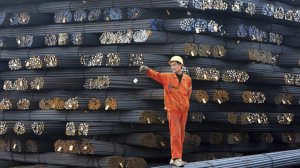 China’s demand of metals and refined copper is expected to rise at least 6% in 2015, roughly in line with this year, supported by new investment in power networks and demand from rail projects, analysts and industry executives said. An expected slowdown in new residential and commercial building projects, however, could see an easing in consumption growth for aluminium and nickel in the world’s top metals consumer. Lead demand growth may also be trimmed by lower production of electric bicycles, while tin demand should be supported by chemicals and tin-coated steel plates makers.
China’s demand of metals and refined copper is expected to rise at least 6% in 2015, roughly in line with this year, supported by new investment in power networks and demand from rail projects, analysts and industry executives said. An expected slowdown in new residential and commercial building projects, however, could see an easing in consumption growth for aluminium and nickel in the world’s top metals consumer. Lead demand growth may also be trimmed by lower production of electric bicycles, while tin demand should be supported by chemicals and tin-coated steel plates makers.
China is expected to complete power network orders from its 2014 power plan next year, as well begin a new investment plan for 2015, said a senior executive at a state-owned copper producer. The power sector is the country’s top copper user. Investment in new power networks had been expected to rise more than 10% in 2014 fell 0.6% in the first half from a year earlier, raising expectations that more orders would be placed between the fourth quarter and early next year. “In China, big (infrastructure) projects usually are started in the third year of a government. Next year is the third year to the current government,” said the executive, who declined to be named because he was not authorised to talk to media.
Rail project orders for power cables and wires have risen since August and could stay strong next year, said a manager at a large end-user of refined copper, who put consumption growth at more than 7% next year. This was above a forecast from state-back research firm Antaike, which put consumption growth at about 6% in 2015, compared to an expected 6.7%-rise to 8.75-million tonnes this year.
Growth could be capped by a fall in demand from air-conditioners makers next year after they raised the output in 2014, said Yang Changhua, senior analyst at state-backed research firm Antaike. China’s still healthy demand rise could help copper prices on the London Metal Exchange, three industry sources said. A trader at a Chinese hedge fund expected the average LME copper price to rise 5% next year from 2014.
New property projects, which typically consume copper, aluminium, zinc and nickel, are likely to slow next year, even though banks have relaxed lending to some house buyers in the past month, cutting existing stocks, metal industry sources said. For aluminium, demand from transport and power transmission may rise next year, said an executive at a state-owned smelter said, who asked not to be named.
Overall consumption of primary aluminium is likely to rise 7-9% next year from about 10% expected in 2014, said the smelter executive and Wang Chunhui, analyst at information provider SMM, who put consumption at 27-million tonnes in 2014.
Production of primary aluminium may rise about 10% to between 30-million and 31-million tonnes next year due to new capacity. High output and lukewarm demand may boost exports of semi-finished products.
A drop-off in new property projects could also affect demand for zinc and nickel, which are used to coat some steel products for the building sector. Zinc is also widely used in infrastructure projects such as power networks and transport. Antaike expects China’s refined tin demand to be flat this year, at just above 150 000 tonnes, and to rise slightly next year due to steady demand from chemicals and tin plated steel products used for packaging. It expects China’s refined lead consumption to rise 4% to about 5.1-million tonnes in 2015 from the year before, compared with a 5-percent rise for 2014 as production of electric bicycles starts to drop after a rapid rise in the past few years.



